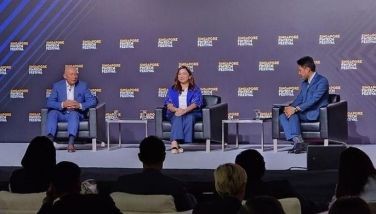What’s new with 3G
January 28, 2006 | 12:00am
The recent decision of the National Telecommunications Commission (NTC) to award 3G frequencies to four cellular operators has paved the way for the entry of third-generation mobile phone technology. But what exactly is 3G and how different is it from the current mobile phone technology?
The first generation (or 1G) was the analog cellphone system. This was the first phase of the liberation of communications from fixed points. You could walk and drive around, and yet be constantly be in touch. 1G, of course, had its limitations. All you could do was talk. And for those old enough to remember, the phones were big, heavy and – relatively speaking – rather clunky.
Then, 2G came along. In the Philippines and much of the world, the dominant 2G technology was the European mobile digital communications standard better known as GSM. With GSM, you could now talk and text. You could download all sorts of stuff using SMS or text messaging – everything from ringtones and logos to the location of your girlfriend. And as GSM developed further (2.5G), you could access the Internet, send and receive multimedia messages, mobile e-mail and other data.
3G takes us one big step up the data services ladder. 3G effectively broadbands mobile phone data services and makes possible the high-speed transmission of data. This is much like the difference between dial-up Internet services and DSL or Smart Wi-Fi. With 3G, more heavy-duty and sophisticated data services become possible.
If you can imagine a huge, multi-lane highway system covering the whole archipelago (the 3G network infrastructure) where all sorts of vehicles (voice, text, SMS and data) can move from one location to another almost instantaneously (high-speed transmission), then this is what 3G can do for wireless communications.
3G’s ability to merge mobile communications with the Internet will result in a richer experience for cellphone subscribers. There will be a ton of new ways for person-to-person (P2P) communications, accessing information, learning and conducting business, and even enjoying entertainment. Each experience with be totally mobile, unique, vivid, convenient and, if necessary, truly interactive.
Like the experience of 1G and 2G, 3G will probably go through a period of experimentation before it gains widespread mass market acceptance. At the start, handsets will be relatively expensive. Over time, however, as more mobile phone users turn to 3G worldwide, economies of scale will kick in, and handset prices will fall.
In the case of Smart Communications Inc., the initial 3G services it intends to make commercially available soon include person-to-person (P2P) video calls, multimedia content streaming and downloading, and high-speed mobile Internet browsing.
For consumers, P2P video calls will be the most visible service offered on 3G networks. With the right handsets (equipped with two cameras that give a view in front and the back of the phone), you can see and hear the person you are talking to right on the display screen of your mobile device.
Imagine being in the office and receiving a call from a friend spending his vacation on the beach. On a standard voice call your friend, describing the wonderful time he is having, can probably make you only slightly envious. However, on a P2P video call, your friend need not say a word, and you will surely be green with envy as you view the scene for yourself – in real time!
Sports fans have alternative means of catching up with the latest competitions, as 3G’s multimedia content streaming and downloading, and high-speed mobile Internet allow them to download clips of sports highlights direct to their phones. The younger set would surely rave about 3G’s ability to deliver music files and music video files right on their devices.
For business and corporate people, 3G promises to make possible more sophisticated business applications for their mobile workforce. For a start, 3G-phone laptops will have quick, easy access to the Internet on the go. Moreover, applications developers will have more platforms upon which they could install more muscular programs designed to address the specific communications needs of businesses.
To date, Smart has demonstrated its 3G services in a number of events in Luzon and the Visayas, such as the Sinulog Festival in Cebu, Ati-Atihan in Kalibo, and Dinagyang in Iloilo.
In Cebu, for example, Smart engineers made a video call from the grandstand of the Abellana National High School (where the main program of the Sinulog festival was being held) to their colleagues in Fuente Osmeña. That video call was projected onto a wide screen at Fuente Osmeña, thus allowing the thousands of people gathered there to see via 3G what was going on at the grandstand.
This weekend, Smart will run another public demo on Boracay Island to show how visitors to the country’s premier resort island can enjoy 3G technology.
3G demos have also been done in several leading universities such as the Ateneo de Manila University and De La Salle University. More campus demos are scheduled over the next two months.
As lifestyles become more and more mobile, people tend to rely more and more on mobile communications. 3G could not have come at a better time.
The first generation (or 1G) was the analog cellphone system. This was the first phase of the liberation of communications from fixed points. You could walk and drive around, and yet be constantly be in touch. 1G, of course, had its limitations. All you could do was talk. And for those old enough to remember, the phones were big, heavy and – relatively speaking – rather clunky.
Then, 2G came along. In the Philippines and much of the world, the dominant 2G technology was the European mobile digital communications standard better known as GSM. With GSM, you could now talk and text. You could download all sorts of stuff using SMS or text messaging – everything from ringtones and logos to the location of your girlfriend. And as GSM developed further (2.5G), you could access the Internet, send and receive multimedia messages, mobile e-mail and other data.
3G takes us one big step up the data services ladder. 3G effectively broadbands mobile phone data services and makes possible the high-speed transmission of data. This is much like the difference between dial-up Internet services and DSL or Smart Wi-Fi. With 3G, more heavy-duty and sophisticated data services become possible.
If you can imagine a huge, multi-lane highway system covering the whole archipelago (the 3G network infrastructure) where all sorts of vehicles (voice, text, SMS and data) can move from one location to another almost instantaneously (high-speed transmission), then this is what 3G can do for wireless communications.
3G’s ability to merge mobile communications with the Internet will result in a richer experience for cellphone subscribers. There will be a ton of new ways for person-to-person (P2P) communications, accessing information, learning and conducting business, and even enjoying entertainment. Each experience with be totally mobile, unique, vivid, convenient and, if necessary, truly interactive.
Like the experience of 1G and 2G, 3G will probably go through a period of experimentation before it gains widespread mass market acceptance. At the start, handsets will be relatively expensive. Over time, however, as more mobile phone users turn to 3G worldwide, economies of scale will kick in, and handset prices will fall.
In the case of Smart Communications Inc., the initial 3G services it intends to make commercially available soon include person-to-person (P2P) video calls, multimedia content streaming and downloading, and high-speed mobile Internet browsing.
For consumers, P2P video calls will be the most visible service offered on 3G networks. With the right handsets (equipped with two cameras that give a view in front and the back of the phone), you can see and hear the person you are talking to right on the display screen of your mobile device.
Imagine being in the office and receiving a call from a friend spending his vacation on the beach. On a standard voice call your friend, describing the wonderful time he is having, can probably make you only slightly envious. However, on a P2P video call, your friend need not say a word, and you will surely be green with envy as you view the scene for yourself – in real time!
Sports fans have alternative means of catching up with the latest competitions, as 3G’s multimedia content streaming and downloading, and high-speed mobile Internet allow them to download clips of sports highlights direct to their phones. The younger set would surely rave about 3G’s ability to deliver music files and music video files right on their devices.
For business and corporate people, 3G promises to make possible more sophisticated business applications for their mobile workforce. For a start, 3G-phone laptops will have quick, easy access to the Internet on the go. Moreover, applications developers will have more platforms upon which they could install more muscular programs designed to address the specific communications needs of businesses.
To date, Smart has demonstrated its 3G services in a number of events in Luzon and the Visayas, such as the Sinulog Festival in Cebu, Ati-Atihan in Kalibo, and Dinagyang in Iloilo.
In Cebu, for example, Smart engineers made a video call from the grandstand of the Abellana National High School (where the main program of the Sinulog festival was being held) to their colleagues in Fuente Osmeña. That video call was projected onto a wide screen at Fuente Osmeña, thus allowing the thousands of people gathered there to see via 3G what was going on at the grandstand.
This weekend, Smart will run another public demo on Boracay Island to show how visitors to the country’s premier resort island can enjoy 3G technology.
3G demos have also been done in several leading universities such as the Ateneo de Manila University and De La Salle University. More campus demos are scheduled over the next two months.
As lifestyles become more and more mobile, people tend to rely more and more on mobile communications. 3G could not have come at a better time.
BrandSpace Articles
<
>
- Latest
Latest
Latest
February 22, 2024 - 3:17pm
February 22, 2024 - 3:17pm
December 28, 2023 - 12:00am
December 28, 2023 - 12:00am
December 11, 2023 - 11:00am
December 11, 2023 - 11:00am
November 23, 2023 - 4:35pm
November 23, 2023 - 4:35pm
October 16, 2023 - 5:00pm
October 16, 2023 - 5:00pm
Recommended





























